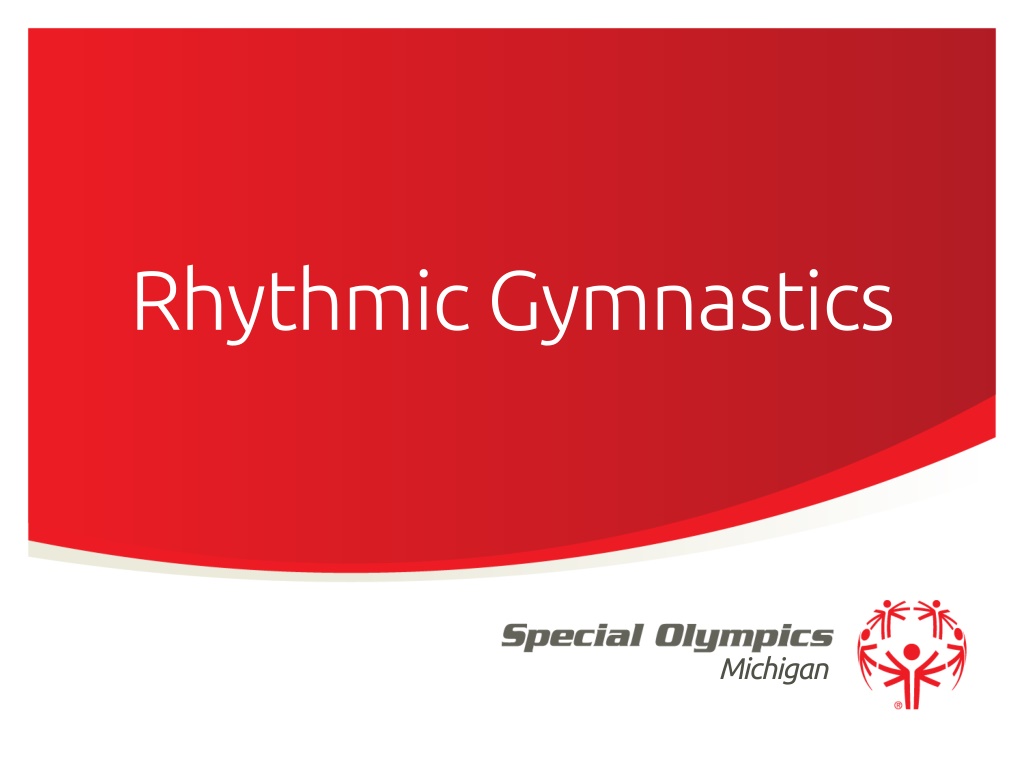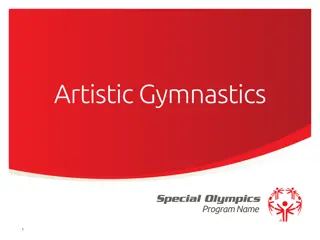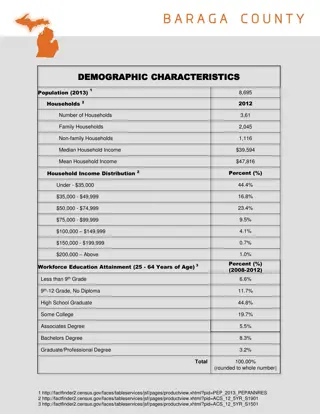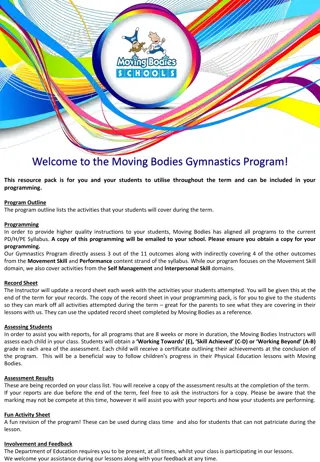Michigan Rhythmic Gymnastics Guidelines and Specifications
Michigan Rhythmic Gymnastics offers a detailed overview of the sport, including competition season, attire guidelines, equipment specifications, and event details such as the State Summer Games. Athletes are required to wear specific uniforms, follow strict rules regarding attire and equipment, and adhere to safety regulations during performances. The guidelines cover aspects like leotard styles, footwear, hairstyles, and jewelry restrictions. Additionally, information on equipment sizes, rope and hoop specifications, as well as event offerings, is provided.
Download Presentation

Please find below an Image/Link to download the presentation.
The content on the website is provided AS IS for your information and personal use only. It may not be sold, licensed, or shared on other websites without obtaining consent from the author. Download presentation by click this link. If you encounter any issues during the download, it is possible that the publisher has removed the file from their server.
E N D
Presentation Transcript
Rhythmic Gymnastics Michigan
General Sport season: March-June Culminating State Event: State Summer Games
Uniform 1. Gymnasts should wear a leotard or unitard of any color. Long tights (down to the ankle) may be worn. 2. Skirted leotards, with the skirt no longer than upper thigh, are acceptable. 3. Leotards may be with or without sleeves, but dance leotards with narrow straps are not allowed. 4. The cut of the leotard at the top of the legs must not go beyond the fold of the crotch (maximum). 5. Any decoration added to the leotard, either loose or stuck to the garment (flowers, ribbons, etc.) must adhere to the leotard.
Uniform 1. Leotards must be non-transparent material. Lace or other sheer fabric should be lined in the trunk area. 2. Bare feet, gymnastics slippers or rhythmic half-slippers (recommended) are acceptable. 3. Hairstyles should be neat. 4. For the safety of the gymnast, no jewelry is allowed.
Equipment & Specifications The size of the equipment can range from child size to senior equipment based on gymnast's size and skill. Equipment should color coordinate with the athlete's leotard. Equipment will be checked prior to competition. If the apparatus does not meet specs, a deduction of .5 each time for individual and 1.0 each time for group will occur. In group routines, all equipment must be identical.
Rope Specifications Rope may be made of hemp or a synthetic material with identical qualities of lightness and suppleness as a rope made of hemp. The rope's length is proportionate to the size of gymnast. Handles of any kind are not allowed at the ends of the rope, but one or two knots are permitted at each end. At the ends, only a maximum of 10 cm may be covered by an anti-slip material either colored or neutral or may be colored (all or partially) apart from the colors gold, silver, or bronze. The rope may be of uniform diameter or be progressively thicker in the center provided that this thickness is of the same material as the rope. The rope may be of a neutral color or may be colored (all or partially) apart from the colors gold, silver, or bronze.
Hoop Specifications The hoop may be made of wood or plastic, provided that the latter retains its shape during the movement. The interior diameter of the hoop is from 60-90 centimeters. The hoop should have a minimum weight of 150-300 grams. A section of the hoop may be in several different shapes: circular, square, rectangular, oval, etc. The hoop may be smooth or ridged, and it may be all or partially covered with adhesive tape either of the same color as the hoop or a different color. The hoop may be a natural color or may be all or partially covered by one or several colors except gold, silver, or bronze.
Club Specifications Clubs may be made of wood or synthetic material and must be between 25-50 centimeters (recommended size 40-50 cm) from one end to the other. A club must be in a similar shape to that of a bottle. The wider part is called the body, the narrow part, the neck and the ends in a small sphere. Clubs may be of a neutral color or may be colored (all or partially) with one or several colors except gold, silver or bronze
Floor Specifications The floor should be 12 meters by 12 meters with a security zone of 1 meter around. A carpeted area may be used or a floor that is neither too tacky nor slippery. A fairly high ceiling is needed.
Ribbon Specifications The stick must be made of wood, bamboo, plastic or fiberglass. The diameter should be a maximum of 1 cm at its widest part. The shape should be cylindrical or conical or a combination of the two shapes The length of the stick should be 45-60 cm including the ring, which fastens the ribbon to the stick. The bottom end of the stick may be covered by an adhesive, anti-slip tape or have a rubber handle. The tape or handle should not exceed 10 cm at level of the grip. The top of the stick where the ribbon attaches may consist of a supple strap or metal ring (See Sports Rules for further details).
Ribbon Specifications Stick may be any color except gold, silver, or bronze. The ribbon material should be satin or a similar non-starched material. The ribbon may be a single color or multi-colored but may not be gold, silver, or bronze. The weight of the ribbon only should be at least 20-35 grams. The width of the ribbon should be 4 to 6 cm. From one end to the other, the finished length of the ribbon should be 2-6 meters (for Levels A, B) and 3-6 meters (for levels 1-4) and this part must be one piece. The ribbon is fixed to the stick by means of an attachment such as thread, nylon cord, or a series of articulated rings. The length of this attachment is a maximum of 7 cm.
General Rules Rhythmic gymnastics athletes may not enter artistic events. Athletes may mix levels. However, if they are competing in the all-around, they must compete at the same level for all events Athletes may enter four events and compete for an all-around award, within the same level. Athletes may also register for group events of Group Ball or Floor Exercise (4 to 6 participants) in addition to the 1 to 4 other events. You must register your athletes for the all-around event to be eligible for the special medal. A score and levels must be listed at registration time.
General Rules The text for all the routines is usually written for right dominant athletes. Left dominant athletes can reverse the whole routine to accommodate their dominant side. Once the routine is started on the dominant side, all aspects of the routine are executed on that same side. It is not recommended that the athlete change from the dominant side to the non-dominant side during any routine. Doing so will add extra steps/movements to the routine which will result in the athlete being deducted for extra steps/movements. 1. Male and female athletes may participate in rhythmic gymnastics in Levels A, B, C, and 1. Only female athletes may participate in rhythmic gymnastics Levels 2, 3 and 4.
General Rules Level A routines have been written for athletes who are unable to stand on their own. They may sit in a wheelchair or sturdy chair to compete. Level A routines are compulsory that are preformed seated. Level B routines Level B routines are the same as Level A routines but performed from a standing position. The video of the compulsory routines is the official version. If a difference exists between the video and the written text, the video must be followed. Olympic order for rhythmic gymnastics competition is rope, hoop, ball, clubs and ribbon.
General Rules Atlantoaxial Instability Rule: Athletes with Down Syndrome must have an x-ray indicating that he/she does not have atlantoaxial instability prior to participation in any gymnastics event.
Floor Exercise For all levels, there is a Floor Exercise routine (except Men s Rhythmic Gymnastics Levels C & 1). The purpose of the Floor Exercise is two-fold: to allow the athletes to perform body difficulties and movements necessary for rhythmic gymnastics without using hand apparatus and to educate coaches and athletes on body waves, body difficulties and dance steps. Floor Exercise is required for all gymnasts in Levels C,1,2,3, & 4. To compete apparatus routines, each athlete must first perform the floor routine. If an athlete is not prepared to do the choreography, he/she must perform and be evaluated on the 8 skills listed on the score sheet.
Floor Exercise Level C gymnasts perform the Level C Floor Routine. Level 1 & 2 gymnasts perform the same Floor Routine (1/2). Level 3 & 4 gymnasts perform the same Floor Routine (3/4). Multiple athletes can perform on the floor at the same time. There will be one judge per athlete. If an athlete performs the choreography, each skill is valued at 3.0. If an athlete performs individual skills instead of the choreography, each skill is valued at 2.0. A total score is not tabulated. No awards are given unless the competition director elects to give participation awards. The score sheets will be distributed to the coaches at the end of the competition.
Event Specific Rules & Modifications LEVEL A (Mixed gender) Apparatus Offered: Floor, Rope, Hoop, Ball, Clubs, Ribbon. Routines are performed seated. Athletes choose any 3 routines to compete. No All-Around awards given. Female & male athletes are awarded together.
Event Specific Rules & Modifications LEVEL B (Mixed gender) Apparatus Offered: Floor, Rope, Hoop, Ball, Clubs, Ribbon These will be the Level A routines performed standing. Athletes choose any 3 routines to compete. No All-Around awards given. Female & male athletes are awarded together.
Event Specific Rules & Modifications LEVEL C (Male & Female) Required for female athletes Floor. Evaluated, but no awards given. Female athletes choose any 2 apparatus routines to compete from: Rope, Hoop, Ball, Clubs, Ribbon. Male athletes choose any 3 apparatus routines to compete from: Rope, Clubs, Stick, Rings. Female & Male athletes are awarded separately. Awards given for apparatus routines. No All-Around awards given.
Event Specific Rules & Modifications LEVEL 1 (Male & Female) Required for female athletes Level 1/2 Floor/free routine. Evaluated, but no awards given. Females - Required 3 mandatory compulsory routines from: Rope, Ball, Ribbon Choose an additional compulsory routine from: Hoop, Clubs Will be awarded as a mixed apparatus, not separately. Males Required apparatus: Rope, Clubs, Stick, Rings
Event Specific Rules & Modifications LEVEL 2 (Female) Required Level 1/2 Floor/free routine. Evaluated, but no awards given. Required 3 mandatory compulsory routines: Hoop, Clubs, Ribbon Choice of an additional compulsory routine from: Rope, Ball Will be awarded as mixed apparatus, not separately.
Event Specific Rules & Modifications LEVEL 3 (Female) Required Compulsory Level 3/4 Floor/free routine. Evaluated, but no awards given. Level 3 apparatus routines will be a hybrid of compulsory & optional. Required 3 mandatory apparatus: Rope, Ball, Clubs Choice of an additional apparatus from: Hoop, Ribbon. Will be awarded as mixed apparatus, not separately.
Event Specific Rules & Modifications Requirements for Optional routines: 3 required body difficulties, with apparatus handling specified 1 jump/leap, 1 pivot, 1 balance. 2 required dance passes, with apparatus handling or body element specified. 3 additional required skills. Athletes can choose to complete the Level 3 compulsory routines or optional routines (with the required skills performed exactly as specified in the videos), or a combination (for example 2 compulsory & 2 optional routines). This way, coaches who do not have choreography experience have routines. Or coaches & athletes moving into optional routines have easier & fewer requirements. Compulsory & optional routines will be awarded together for each apparatus. Max. time for optional routines: 1:15
Event Specific Rules & Modifications LEVEL 4 (Female) Required Compulsory Level 3/4 Floor/free routine. Evaluated, but no awards given. Required apparatus routines: Hoop, Ball, Clubs, Ribbon
Event Specific Modifications Athletes with hearing or visual impairments are allowed cues and signals from the coach. Coaches must notify the meet director and judges of the athlete s impairment before the event begins. Modifications for athletes using canes or walkers: In the floor exercise, coaches may walk onto the floor and remove (and replace) walkers and other aids as needed without any deduction.
Disqualifications A competitor may be disqualified if he/she: Is wearing improper attire. Undisciplined or unsportsmanlike behavior. Improper equipment and use of aids. Has assistance from a coach during a competition
Routines To view videos of the rhythmic routines please visit: http://somi.org/sports/sports-gymnastics.html























